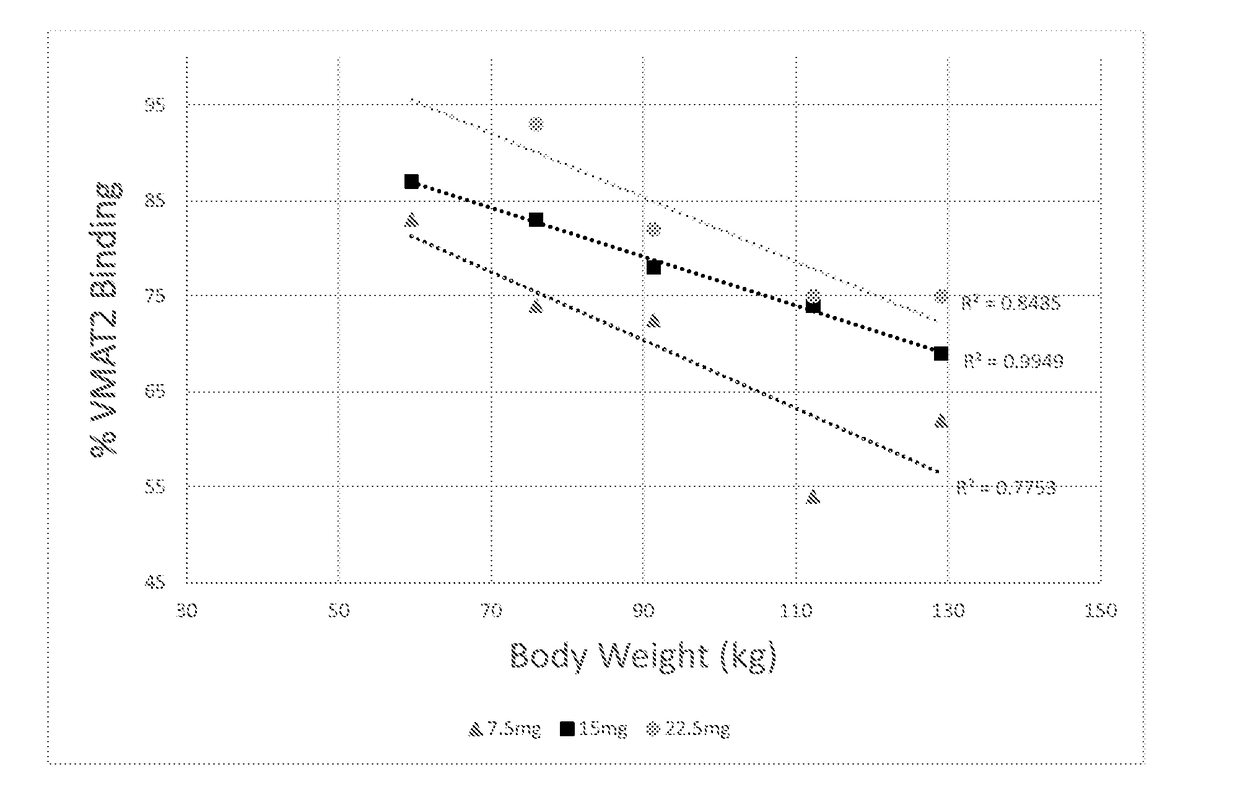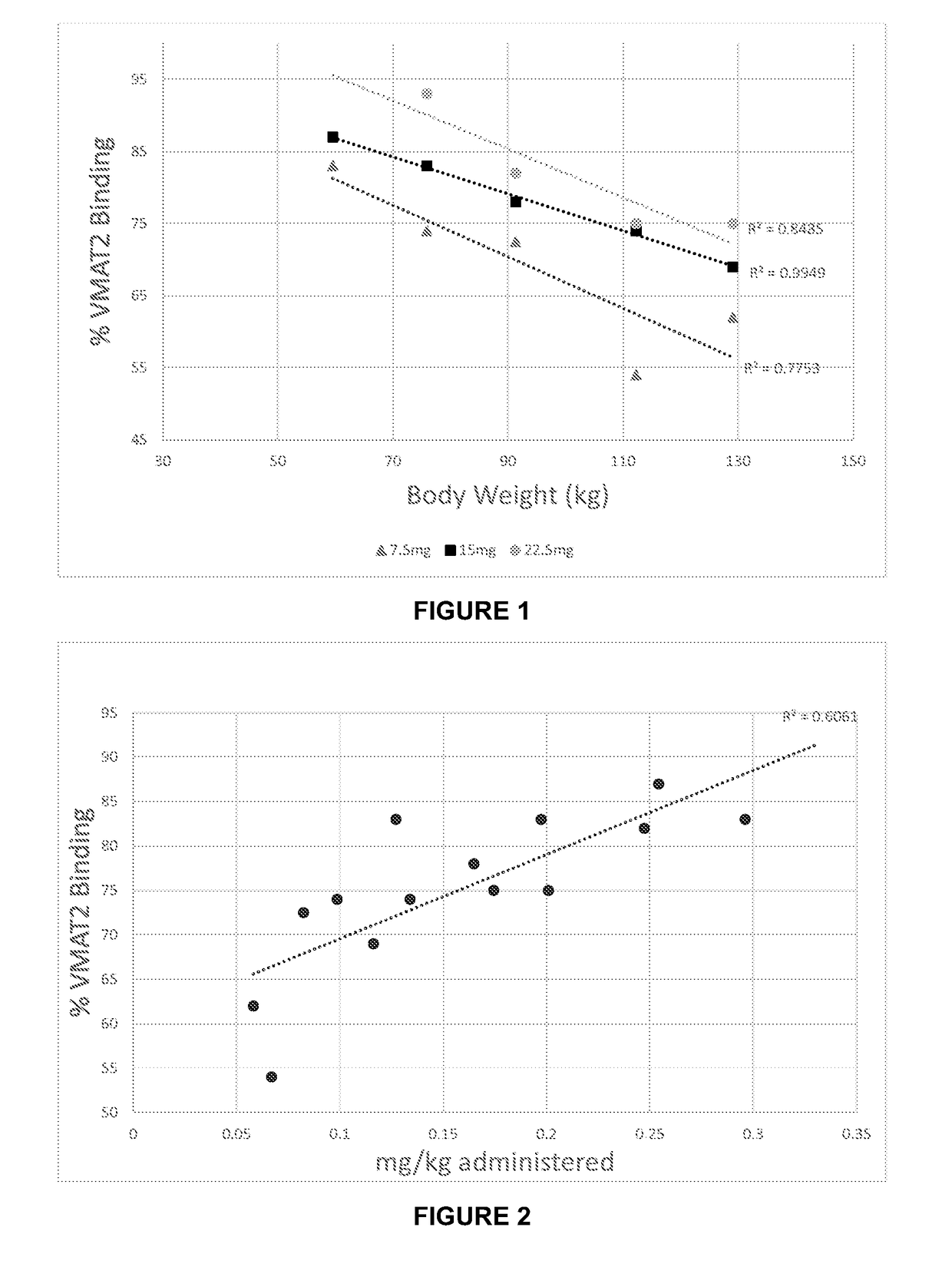Pharmaceutical compositions
a technology of pharmaceutical compositions and compositions, applied in the field of hyperkinetic movement disorders and hypokinetic movement disorders, can solve the problems of depletion of dopamine levels in the brain, abnormal and/or excessive movements, tremors,
- Summary
- Abstract
- Description
- Claims
- Application Information
AI Technical Summary
Benefits of technology
Problems solved by technology
Method used
Image
Examples
example 1
[0170](+)-α-Dihydrotetrabenazine in defined amounts was administered by oral dosing to five human volunteers. In four of the volunteers, blood sample were taken at 30, 60, 120 and 180 minutes after drug administration. Blood samples were not taken from the fifth volunteer. At 60 minutes after drug administration, PET scans were initiated and these were stopped at 120 minutes after drug administration.
[0171]The experiment was carried out at dosages of 7.5 mg, 15 mg and 22.5 mg.
Results
[0172]Table 1 shows the plasma concentrations in nanogrammes / ml of (+)-α-dihydrotetrabenazine in five human subjects, 0.5, 1, 1.5, 2 and 3 hours after a dose of 7.5 mg, 15 mg and 22.5 mg. Table 2 shows the % VMAT2 blocking following administration of 7.5 mg, 15 mg and 22.5 mg of (+)-α-dihydrotetrabenazine in all five subjects.
TABLE 1TimeSubject #(h)123456Body11276129599168Weight(kg)Dose(oral) 7.5 mg0.5BLQ0.5310.2168.436.68BLQ10.9413.74.3515.09.83.771.52.3910.86.9120.713.53.0622.4414.05.0317.610.74.3333.0...
example 2
n of the Effect of Dihydrotetrabenazines and Risperidone on Amphetamine-Induced Hyperlocomotion
[0179]Dopaminergic models for Tourette's syndrome use systemic or focal administration of dopamine agonists such as amphetamine. After injection with amphetamine, a test animal expresses stereotypic behaviour. In particular, involvement of a dopaminergic system implicated in Tourette's syndrome wild type mice and rats can be stimulated with amphetamine and the resulting hyperactivity and stereotypes can be reversed with dopamine antagonists such as risperidone and haloperidol (Tourette's syndrome—Animal Models for Screening, Charles River Discovery Research Services, Finland).
[0180]Amphetamine produced a rise in extracellular concentrations of brain dopamine and concomitant behavioural manifestations in the rat and other species. At relatively low doses (1.2 ng / kg i.p.) amphetamine increases locomotor behaviour, ceases movement and gives way to a stationary posture accompanied by highly re...
PUM
| Property | Measurement | Unit |
|---|---|---|
| weight | aaaaa | aaaaa |
| weight | aaaaa | aaaaa |
| weight | aaaaa | aaaaa |
Abstract
Description
Claims
Application Information
 Login to View More
Login to View More - R&D
- Intellectual Property
- Life Sciences
- Materials
- Tech Scout
- Unparalleled Data Quality
- Higher Quality Content
- 60% Fewer Hallucinations
Browse by: Latest US Patents, China's latest patents, Technical Efficacy Thesaurus, Application Domain, Technology Topic, Popular Technical Reports.
© 2025 PatSnap. All rights reserved.Legal|Privacy policy|Modern Slavery Act Transparency Statement|Sitemap|About US| Contact US: help@patsnap.com



